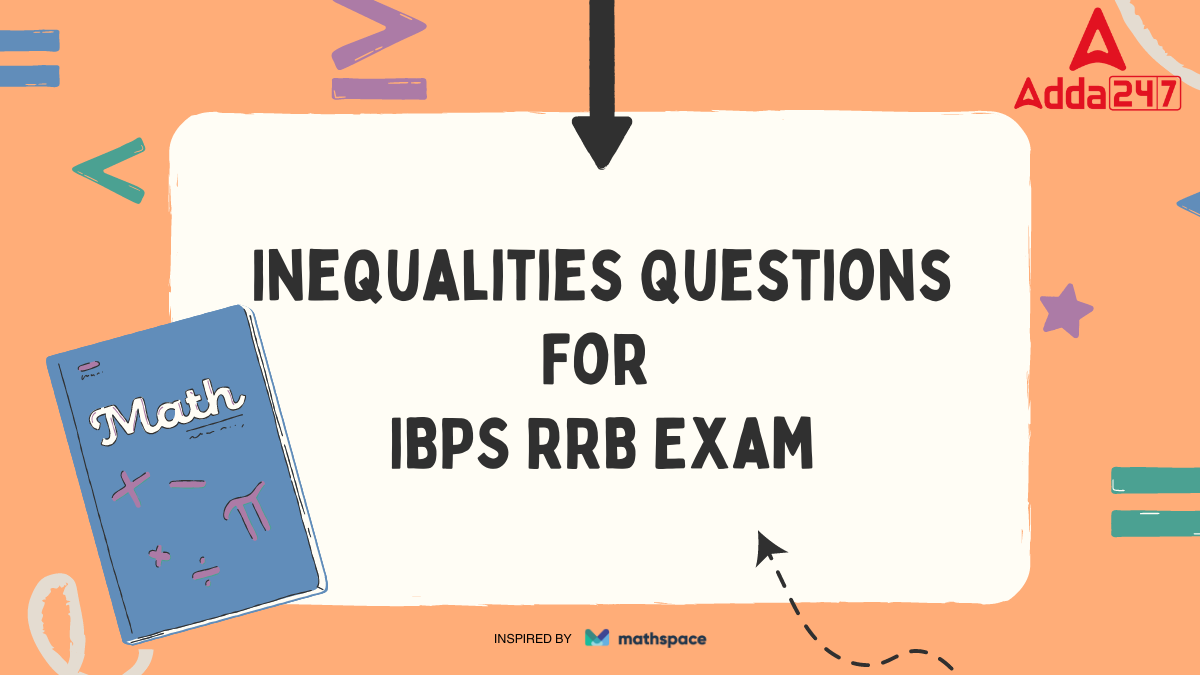Inequality questions form an essential part of the reasoning section in the IBPS RRB exam and are known for being both high-scoring and time-efficient. These questions test a candidate’s understanding of comparative relationships and logical deduction. Whether it’s direct or coded inequalities, the objective remains the same: identify the valid conclusions based on the given statements. In recent years, the IBPS RRB exam has consistently included 4 to 5 inequality questions, making it a reliable scoring area for aspirants. In this article, we’ll look at the types of inequality questions typically asked, review patterns from previous years, and provide examples to help you prepare more effectively.
Inequalities for RRB Bank Exams
Inequalities questions are a part of the logical reasoning section in the IBPS RRB exam. These questions are designed to evaluate a candidate’s ability to understand and manipulate mathematical relationships and inequalities.
The questions typically involve symbols such as
- > Greater than,
- < Less than,
- ≥ Greater than or Equal to,
- ≤ Less than or Equal to, and
- = Equal to
Candidates need to determine the relationship between different variables based on the given inequalities.
Types of Inequalities Questions
1. Direct Inequalities: In direct inequalities, candidates are provided with a set of statements containing inequalities, and they need to find the correct relationship between the variables. For example:
- Given: A > B, B > C
- Question: What is the relationship between A and C?
- Answer: A > C
2. Coded Inequalities: Coded inequalities involve symbols that represent the standard inequality signs. Candidates need to decode the symbols and solve the inequalities accordingly. For example:
- Given: A @ B means A > B, A # B means A = B, A $ B means A < B
- Question: If P @ Q and Q $ R, what is the relationship between P and R?
- Answer: P > Q > R, so P > R
3. Combined Inequalities: In these questions, multiple inequalities are given, and candidates need to combine them to determine the relationship between two variables. For example:
- Given: A > B, B = C, C < D
- Question: What is the relationship between A and D?
- Answer: A > B = C < D, so the relationship between A and D cannot be determined directly.
Inequality Questions Asked Last Year in IBPS RRB Exam
Directions (01-03): In these questions, relationships between different elements are shown in the statements. The statements are followed by conclusions. Study the conclusions based on the given statements and select the appropriate answer:
Q1.
Statements: P>Q=R≥S<T, U≤S>W
Conclusions: I. P>T II. W<P
(a) If only conclusion I is true.
(b) If only conclusion II is true.
(c) If either conclusion I or II is true.
(d) If neither conclusion I nor II is true.
(e) If both conclusions I and II are true.
Q2.
Statements: M=N≤O>G<Q≤R, S<R=T
Conclusions: I. G<T II. G≥R
(a) If only conclusion I is true.
(b) If only conclusion II is true.
(c) If either conclusion I or II is true.
(d) If neither conclusion I nor II is true.
(e) If both conclusions I and II are true.
Q3.
Statements: B≥C≥D=E>F≤G<Y≤H
Conclusions: I. C<E II. G<D
(a) If only conclusion I is true.
(b) If only conclusion II is true.
(c) If either conclusion I or II is true.
(d) If neither conclusion I nor II is true.
(e) If both conclusions I and II are true.
Directions (04-06): In each of the questions, relationships between some elements are shown in the statements. These statements are followed by conclusions numbered I and II. Read the statements and give the answer.
Q04.
Statements: H > I = J ≥ K < N, L ≤ N = M < P ≤ Q
Conclusions: I. P > K II. L ≤ Q
(a) If only conclusion I is true.
(b) If only conclusion II is true.
(c) If either conclusion I or II is true.
(d) If both conclusions I and II are true.
(e) If neither conclusion I nor II is true.
Q05. Statements: M ≥ N > O > P ≥ R, Q ≤ O = L > S
Conclusions: I. S < M II. L > R
(a) If only conclusion I is true.
(b) If only conclusion II is true.
(c) If either conclusion I or II is true.
(d) If both conclusions I and II are true.
(e) If neither conclusion I nor II is true.
Q06. Statements: D ≤ E > F > G = H < I, H ≥ K < Z = U
Conclusions: I. F > Z II. D < I
(a) If only conclusion I is true.
(b) If only conclusion II is true.
(c) If either conclusion I or II is true.
(d) If both conclusions I and II are true.
(e) If neither conclusion I nor II is true.
Directions (07-09): In the question below, relationship between different elements is shown in the statement. These statements are followed by two conclusions. Give answer:
Q07. Statement: X ≥ E > Z = W ≤ D < U ≥ T
Conclusions: I. U > Z II. X ≥ W
(a) Only conclusion I is true
(b) Only conclusion II is true
(c) Either conclusion I or II is true
(d) Neither conclusion I nor II is true
(e) Both conclusion I and II are true
Q08. Statement: M > Q ≤ R = S ≥ B ≥ U > V
Conclusions: I. Q ≤ S II. V < R
(a) Only conclusion I is true
(b) Only conclusion II is true
(c) Either conclusion I or II is true
(d) Neither conclusion I nor II is true
(e) Both conclusion I and II are true
Q09. Statement: P ≤ G > H ≥ A = C < K ≤ S
Conclusions: I. G ≤ K II. G > K
(a) Only conclusion I is true
(b) Only conclusion II is true
(c) Either conclusion I or II is true
(d) Neither conclusion I nor II is true
(e) Both conclusion I and II are true
Directions (10-11): In these questions, relationships between different elements are shown in the statements. The statements are followed by two conclusions. Study the conclusions based on the given statements and select the appropriate answer:
Q10. Statement: M ≥ N = O < P < R; S ≤ T = U > V ≥ P > X
Conclusions: I. N < T II. R > U
(a) Only conclusion I is true
(b) Only conclusion II is true
(c) Either conclusion I or II is true
(d) Neither conclusion I nor II is true
(e) Both conclusion I and II are true
Q11. Statement: A < B ≥ C = F > E < D < G; I ≤ L = J ≤ F < K
Conclusions: I. B > I II. I = B
(a) Only conclusion I is true
(b) Only conclusion II is true
(c) Either conclusion I or II is true
(d) Neither conclusion I nor II is true
(e) Both conclusion I and II are true
Directions (12-14): In each of the questions, relationships between some elements are shown in the statements. These statements are followed by conclusions numbered I and II. Read the statements and give the answer.
Q12. Statements: A < B ≤ C = D, D > E ≥ F > G
Conclusions: I. D ≥ B II. G < C
(a) If only conclusion I is true.
(b) If only conclusion II is true.
(c) If either conclusion I or II is true.
(d) If both conclusions I and II are true.
(e) If neither conclusion I nor II is true.
Q13. Statements: P < Q > R ≤ S > T ≤ U = V
Conclusions: I. P > V II. U ≥ P
(a) If only conclusion I is true.
(b) If only conclusion II is true.
(c) If either conclusion I or II is true.
(d) If both conclusions I and II are true.
(e) If neither conclusion I nor II is true.
Q14. Statements: X = Y < Z ≤ W, Y > V ≥ U ≤ A < B
Conclusions: I. Z > B II. X ≤ V
(a) If only conclusion I is true.
(b) If only conclusion II is true.
(c) If either conclusion I or II is true.
(d) If both conclusions I and II are true.
(e) If neither conclusion I nor II is true.
Directions (15-17): In these questions, relationship between different elements is shown in the statements. These statements are followed by two conclusions. Give answer
Q15. Statements: J ≤ K < L = M > N ≥ O
Conclusions: I. K < N II. J < M
(a) If only conclusion I is true.
(b) If only conclusion II is true.
(c) If either conclusion I or II is true.
(d) If neither conclusion I nor II is true.
(e) If both conclusions I and II are true.
Q16. Statements: P = Q ≤ R < S = T ≥ U
Conclusions: I. Q < T II. S ≥ U
(a) If only conclusion I is true.
(b) If only conclusion II is true.
(c) If either conclusion I or II is true.
(d) If neither conclusion I nor II is true.
(e) If both conclusions I and II are true.
Q17. Statements: X ≥ Y < Z = A ≤ B = C
Conclusions: I. X < A II. X ≥ B
(a) If only conclusion I is true.
(b) If only conclusion II is true.
(c) If either conclusion I or II is true.
(d) If neither conclusion I nor II is true.
(e) If both conclusions I and II are true.
| Solutions | |||||||||
| 01 | b | 02 | a | 03 | d | 04 | a | 05 | d |
| 06 | e | 07 | a | 08 | e | 09 | c | 10 | a |
| 11 | c | 12 | d | 13 | c | 14 | e | 15 | b |
| 16 | e | 17 | d | ||||||




 GIPSA Approves New Officer Designations ...
GIPSA Approves New Officer Designations ...
 Cabinet Clears Insurance Amendment Bill ...
Cabinet Clears Insurance Amendment Bill ...
 CAIIB ABFM Exam Analysis 2025, 13 Decemb...
CAIIB ABFM Exam Analysis 2025, 13 Decemb...







